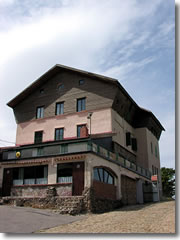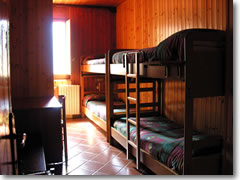Mountain huts
European mountain huts and mountain refuges
 The Rifugio Orestano (www.rifugiorestano.com), a mountain refuge built in the 1920s on the Piano Zucchi (3646 feet above sea level) in Sicily's Parco delle Madonie.
The Rifugio Orestano (www.rifugiorestano.com), a mountain refuge built in the 1920s on the Piano Zucchi (3646 feet above sea level) in Sicily's Parco delle Madonie.
• Intro
• Costs
• Resources & linksPicture a high-altitude hostel with Alpine flair: cozy bunks with thick blankets, hearty food (if offered), a common room filled with ruddy-faced outdoorsy types, and killer vistas.
Some are scattered along winding roads. Others are glorified cow sheds in places you can't get to without hiking a few miles (if not all day), where you can shack up for the night whilst trekking across the Alps, Pyrenees, Dolomites, Apennines, or other mighty European mountain chain.
Profile of an Italian rifugio
Want to know what a mountain hut is like in detail? Check out this review (on our sister site ReidsItaly.com) of the Rifugio Nino Perinici in Italy's Trentino region, a few hours' hike from Lake Garda but just a 20-minute stroll from a nearby road. ![]() You're most likely to share space with solo Italian hikers and groups of Germans exploring the Alps by foot or mountain bike.
You're most likely to share space with solo Italian hikers and groups of Germans exploring the Alps by foot or mountain bike.
Alpine huts range from woodland hostels in the low hills of Sicily (one is pictured to the left and below) to the Alps' Capanna Regina Margherita atop Monte Rosa (www.monterosa4000.it), Europe's highest mountain refuge at an oxygen-starved 14,941 feet.
Many are only open during the summer hiking season (usually June to late September), though some set aside a handful of beds for year-round use.
Though a mattress and blanket are provided, you must also bring and use your own sleep sack or sleeping bag (this is for cleanliness and environmental reasons, as it reduces their laundry load).
Tip: Make sure you stay in a full-fledged rifugio; the other lodgings up in the rarefied air are bivacchi, bare-bones shelters for folks caught on a peak in inclement weather or on long trails between refuges.
How much do mountain refuges cost?
The more isolated huts—many of them unstaffed—often ask you to leave a small donation or are completely free of charge.
Those you can drive to usually charge a fee ranging from nominal to about the cost of a two-star hotel (though in popular hiking areas in high summer, the price may go as high as a three-star).
As an example in Italy: By agreement, per-person rates cannot exceed €20–€26 in a dorm (rooms with 2–6 beds may charge more, up to €43 per person). Members of CAI (the official association) pay about half that (you can apply to any local CAI group; usually €50–€65 for the first year, a bit less for those under age 30).
In practice, most huts charge less than the max, around €16–€19 (breakfast may be free, or a modest extra).
If offered, half-board (breakfast and dinner) adds €10–€30.
Huts that remain open in winter (Dec–Apr) may charge non-members a 30% premium for heating.
Resources for finding mountain huts and alpine refuges
IN FRANCE
Gîtes d'Etape et Refuges (www.gites-refuges.com) - Nearly 4,000 mountain huts, refuges, hiking hostels, and trekking cabins across France.
IN ITALY (rifugi)
 A room in the mountain hut Rifugio Orestano (www.rifugiorestano.com), Parco delle Madonie, Sicily.
A room in the mountain hut Rifugio Orestano (www.rifugiorestano.com), Parco delle Madonie, Sicily.
Club Alpino Italiano (www.cai.it) - Italy's premier mountaineering organization owns 600 rifugi (alpine huts) and maintains an online database at rifugi.cai.it. However, this is woefully lacking in data (many refuges now have Web sites, a fact rarely included in the database).
Far more useful are the regional CAI associations. You can find these by staying in the Italian-language version of the main cai.it (rather than the stripped-down English language version) and clicking on "Le Sezioni del CAI" in the left menu; the clickable map of Italy will direct you to regional CAI groups.
Touring Club Italiano (www.touringclub.it) - The Italian equivalent to AAA publishes several books of mountain itineraries (the Guide Monti Italia series) with info on the huts used. You can pick these up at any decently-sized book store in Italy.
IN SPAIN
The Mountaineering Club of Basque Country (www.mendikoweb.com)
IN SWITZERLAND
Swiss Alpine Club (www.sac-cas.ch)
Schwizer Bergh ütten (www.bergtourismus.ch)
IN THE U.K. (bothies)
Mountain Bothies (www.mountainbothies.org.uk) - A network of around 100 mountain huts in the remoter parts of the U.K., mostly in Scotland but also some in Wales and Northern England. Range from sheds to seven-room houses—but most very basic (bring your own sleeping bag and pad), few with toilet facilities (bring your own TP). On the plus side, they're free—though the organization that maintains them does gratefully accept donations, and offers annual memberships.
National Trust (www.nationaltrust.org.uk) - A database of campgrounds, bunkhouses, bothies (mountain huts), camping pods, yurts, and more all across the UK.
England: Lakeland Camping Barns (www.lakelandcampingbarns.co.uk) - A dozen camping barns throughout Cumbria and the Lake District that can house eight to eighteen visitors per night for £8.50 a head.
Shetland Islands: Camping Böds (www.camping-bods.co.uk) - Basic old fishing shacks and cottages (böd comes from the old Norse for shack) available for camping for £8 per person with electricity, £6 without. Nine options across the Shetlands.
Hebridean Islands: Gatliff Hebridean Hostels Trust (gatliff.org.uk) - A trio of crofters hostels charging £10 for a bunk and blanket, with gas stoves and cooking equipment provided. Hotel and cold running water; heated.
Section Index
|
Related Partners
|
This article was by Reid Bramblett and last updated in April 2011.
All information was accurate at the time.
Copyright © 1998–2013 by Reid Bramblett. Author: Reid Bramblett.

